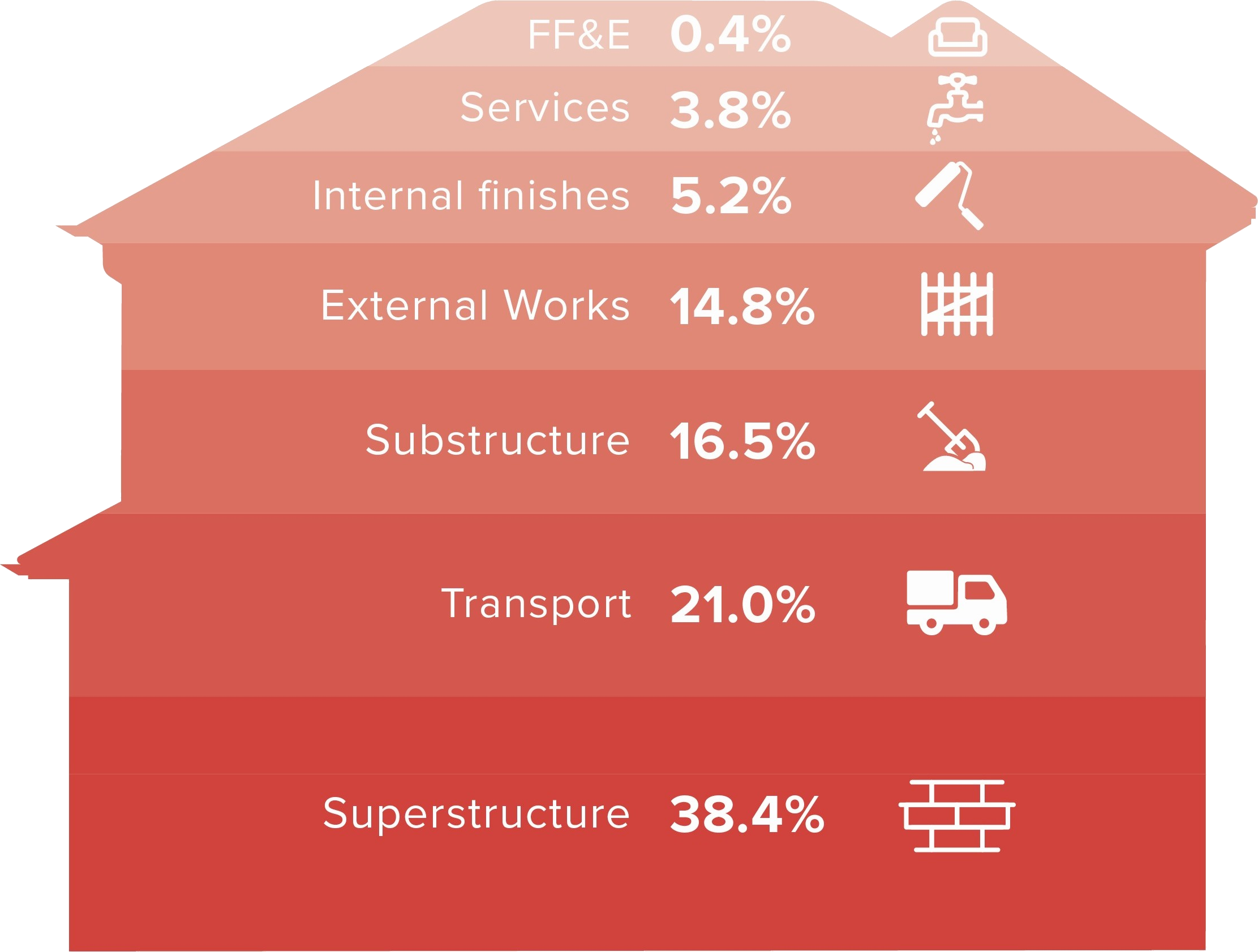
REDROW’S COMMITMENTS TO CLIMATE CHANGE
Responding to the climate crisis is our highest environmental priority and our primary focus is to decarbonise our business across the whole value chain. At the same time, we also need to adapt to the changing climate and our strategy is designed to do both.
Redrow have set an ambitious commitment to achieve science-based net-zero emissions by no later than 2050 across our operations, the homes we build, and the operations within our supply chain. This includes both direct and in-direct carbon emissions from scopes 1, 2 & 3.
We are delighted to announce that the Science Based Targets initiative (SBTi) has approved our near-term science-based carbon emissions reduction target which was submitted for validation last year.
Our approved near-term science-based targets.
- Reduce absolute scope 1 and scope 2 emissions 42% by FY2030 from a baseline year FY2021.
- Reduce absolute scope 3 emissions 25% by FY2030 from a baseline year FY2021.
Redrow has also committed to set long-term emissions reduction targets with the SBTi in line with reaching net-zero by 2050.
As a business, we are working towards addressing climate change by reducing our emissions. We believe there is a great opportunity to learn from the science here, through innovation in the way we operate, and future-proofing the homes and communities that we build. We will be building on the good work that we have already achieved on carbon reduction to date and taking the necessary changes to become a low carbon business.
You can read more here.


Our carbon reduction route map by 2030

CARBON REDUCTION INITIATIVES
We’re continually looking to enhance and improve our business practices to reduce our emissions. These are some of the ways in which we are achieving this:
Scope 3

SUPPLY CHAIN COLLABORATION
Our indirect scope 3 emissions account for nearly 99% of our total carbon footprint. Our largest scope 3 emissions categories are:

With product related emissions accounting for 38% of our total scope 3 emissions, achieving our near-term carbon reduction target will require a transformation across key elements of the supply chain, with a step change in innovation and increased availability of low-carbon products. This demands a change in the way the materials and products we buy are designed, manufactured and distributed, and their raw-material composition. Supporting our supply chain on the route to net zero will be essential to our success.


LOWER CARBON HOMES
The Government has stated its intent to move away from fossil fuel boilers and ensure that as part of the Future Homes Standard, new homes will have high levels of energy efficiency and low carbon heating. The recently introduced interim changes to the Building Regulations required us to reduce the carbon emissions of our homes by at least 31% raising to 75-80% in 2025. Redrow houses built to the new standards will be fitted with air source heat pumps which will significantly reduce the CO2 emissions associated with heating and hot water. Based on current energy assessments we estimate this to be in the region of 84% on average. This is over and above the requirements of the Building Regulation standards and leaves us well positioned with the approach of the Future Homes Standard in advance of 2025. As we move towards a decarbonised electricity grid, the Government expects homes built to the Future Homes Standard will become net zero carbon over time as they will not be reliant on fossil fuels for their heating.

Innovation and new technology are key to unlocking the solutions required to reach net zero emissions. The homes we will build to the new Future Homes Standard (FHS) will be fitted with air source heat pumps, which we estimate will reduce the CO2 emissions from heating and hot water by around 84%. Customers will also benefit from a more energy efficient home, which requires less energy to heat. We’re trialling the latest heat pump technology at Great Milton Park in South Wales and are gathering customer feedback to help shape our approach to zero carbon homes.

We’re also undertaking an innovative trial of Wondrwall’s gas-free heating system, which has been installed into a home at Langley Grange in Yorkshire. The home includes infrared heating panels, an intelligent hot water cylinder, solar PV and battery storage. The intuitive system automatically controlling heating, lighting, security, safety and entertainment, with voice control technology and a mobile phone app. We are collecting data on the home’s overall energy efficiency and will evaluate its carbon footprint against one of our standard homes. This trial demonstrates our commitment to finding less carbon intensive solutions for heating and hot water as part of our drive to cut carbon emissions.

We offer customers the opportunity to upgrade their homes by adding solar PV panels through MyRedrow, our online sales system. This reduces the customer's reliance on grid electricity and reduces their utility bills. It also improves the home’s EPC rating, which is a score relating to the cost of energy needed to run a particular home, while reducing CO2 emissions. The average EPC rating for our homes is B, but the integration of solar PV can improve this to an A rating.
Climate risk and disclosure

Our commitment to achieve net zero carbon across our own operations, new homes and supply chain operations by 2050 will minimise our impact on the climate. It will also future-proof the homes and communities we create to future changes in climate.
Climate change presents challenging risks and uncertainties for business and society, however it also provides opportunities to be innovative in reducing emissions and adapting to its impact.
We have been disclosing our carbon emissions and reduction activities to the Carbon Disclosure Project (CDP) annually since 2010. In the most recent submission, which can be viewed here, we were awarded a C grade which reflects the progress we have made by measuring awareness, management and actions taken on climate change. Our CDP questionnaire provides more detail on our climate-related risks and opportunities and how these are managed within the business.


For the last two years Redrow have been reporting climate-related disclosures following the TCFD’s recommendations and have structured our responses around the four key thematic areas. This year our TCFD report builds upon our previous reporting, to fully comply with:
• Governance (all recommended disclosures);
• Strategy (Disclosure A – time horizons climate assessment, partially compliant in Disclosure B – business, planning and finance planning and C – resilience of strategy);
• Risk Management (all recommended disclosures); and
• Metrics and Targets (Disclosures A – metrics disclosed and C – targets, partially compliant in Disclosure B – emissions).
We have built on previous years disclosure following the TCFD recommendations, by examining a range of possible climate scenarios and the impact of each on Redrow’s business. Our long-term strategy will embed these impacts into governance and processes to ensure a strategic response and practical implementation to prepare the business for a changing world. Our TCFD report is included within our Annual Report, available here.
Greenhouse gas emissions data
Greenhouse Gas (GHG) emissions data for the period 1 July 2021 to 30 June 2022 are set out in the table below.
|
Emissions from: |
Current Reporting Year (1 Jul 21 to 30 Jun 22) |
Previous Year (1 Jul 20 to 30 Jun 21) |
Units |
|
Scope 1 activities: • Direct emissions from combustion of fuels and business travel |
9,558 |
11,417 |
Tonnes of CO2e |
|
Scope 2 activities – Location Based: • Indirect emissions from purchased electricity and heat |
2,591 |
3,263 |
Tonnes of CO2e |
|
Scope 2 activities – Market Based |
264 |
4,682 |
Tonnes of CO2e |
|
Outside of Scopes* |
3 |
N/A |
Tonnes of CO2e |
|
Total Greenhouse Gas Emissions – Location Based: • (Scope 1 and Scope 2) |
12,149 |
14,680 |
Tonnes of CO2e |
|
Total Greenhouse Gas Emissions – Market Based: • (Scope 1 and Scope 2) |
9,822 |
16,099 |
Tonnes of CO2e |
|
Intensity ratio: |
|
|
|
|
Total Greenhouse Gas emissions per 100m2 of build (Location Based) |
2.16 |
2.84 |
Tonnes of CO2e per 100m2 of build |
|
Total Greenhouse Gas emissions per 100m2 of build (Market Based) |
1.75 |
3,11 |
Tonnes of CO2e per 100m2 of build |
Notes to the Greenhouse Gas Emissions Data
This disclosure includes all of the emission sources required under the Companies Act 2006 (Strategic Report and Directors’ Report) Regulations 2013. These sources fall within our consolidated financial statement and we do not have responsibility for any emission sources that are not included in our consolidated statement.
We have used the WRI/WBCSD GHG Protocol – A Corporate Accounting and Reporting Standard and the emissions have been calculated using the 2022 UK Government’s Greenhouse Gas Conversion Factors for Company Reporting. Reported Scope 2 emissions are calculated using both the location-based and market based methods.
This inventory of greenhouse gas emissions has been verified by SGS to a limited level of assurance, in accordance with the requirements of EN ISO 14064-3:2006, as meeting the requirements of The Greenhouse Gas Protocol – A Corporate Accounting and Reporting Standard. Further details and the independent assurance report can be found by clicking here.
Embodied carbon in our homes
We funded an embodied carbon study of a standard ‘Oxford’ house type, using the LifeCYCLE carbon model. The study focused on the ‘Product and Construction’ stage which included embodied carbon associated with the manufacturing and installation of the components used for the substructure, superstructure, internal finishes, furniture/ fixtures and equipment (FF&E), services, external works and transportation.
The results of the study show that the Oxford house type achieves the Royal Institute of British Architects (RIBA) Embodied Carbon target for 2025, set within their 2030 Climate Challenge (less than 800 kgCO2e/m2). The Oxford house type emits a total of 704 kgCO2e/m2 during the ‘Product and Construction’ stage. The breakdown can be seen on the right.

We use a number of materials and products that are considered to have low embodied carbon and our standard specification includes the following products:
- Roofing tiles: innovative interlocking concrete tiles that have 40% less CO2 emissions per m2 roof compared to concrete plain tiles.
- Concrete roof tiles in place of clay tiles: the embodied energy of clay tiles is 270 – 430 MJ/m2 while for concrete it is 40 – 90 MJ/m2.
- Aircrete concrete blocks: up to 80% of the raw materials used in the manufacture of the blocks are recycled products, with the primary ingredient being Pulverised Fuel Ash (PFA) which is a by-product of coal fired power stations that would otherwise be sent to landfill.
- Gypsum plasterboard: produced by using either natural gypsum, synthetic gypsum (from desulphurising the flue gas of coal-fired power plants) or recovered gypsum from the waste-recycling chain.
- Locally recycled aggregates.
Further research into the embodied carbon of our homes that are built to 2021 regulations will be undertaken in the coming year.
We have worked with Carbon Trust to measure the baseline of our scope 1, 2 and 3 emissions and create our carbon reduction strategy and the route map, highlighting some of our key milestones between now and 2030.











